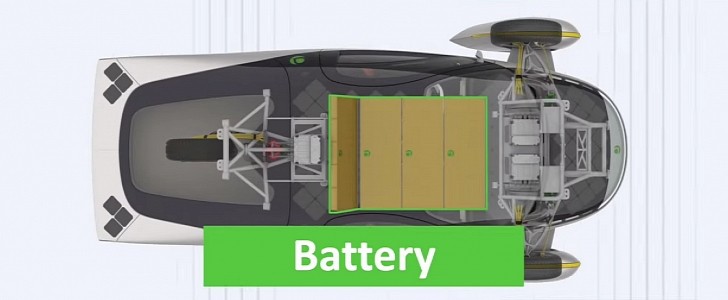If Aptera wants to start delivering its vehicles by the end of this year, it has to get all components ready as soon as possible. The latest update from the company relates to the battery pack. Aptera finalized its production-intent battery pack and disclosed some interesting facts about it.
The entry-level trike will have a 41-kWh battery pack, which is slightly bigger than the 40-kWh unit we thought it would have. The package comprises six battery modules connected by Aptera’s patent-pending bus bar design. Each of them presents 416 cells, which makes this Aptera option present 2,496 cells.
Considering that each of these battery modules presents around 6.83 kWh, we can do a quick calculation to estimate how the 60-kWh and 100-kWh battery packs will be. The former may have nine battery modules and, consequently, 61.5 kWh. The latter should have 15, bringing its capacity to 102.5 kWh.
That is only valid if you consider all battery modules will have the same size. The largest battery pack option may demand Aptera to adapt the modules so that they can all fit in the vehicle. The EV will have a liquid-cooled battery system and no radiators: the body will have channels through which the liquid will circulate, making the Aptera adopt a skin-cooling method.
The company’s engineers said in the video below that they did their best to eliminate all unnecessary components from the battery pack. Apart from making the Aptera lighter, that also helps to increase energy density. The 41-kWh battery pack has an energy content equivalent to 1.5 gasoline gallons and an estimated range of 400 miles (644 kilometers). That means it will get 10 miles/kWh (16.1 km/kWh).
When the electric trike is put for sale, these numbers will make it one of the most energy-efficient vehicles available in the market. Only the Nimbus Halo may travel further than the Aptera: 11 mi/kWh. However, it’s been a while since we last heard from Nimbus, so Aptera’s only opponents in terms of efficiency may end up being the Lightyear One and Lucid Air.
Considering that each of these battery modules presents around 6.83 kWh, we can do a quick calculation to estimate how the 60-kWh and 100-kWh battery packs will be. The former may have nine battery modules and, consequently, 61.5 kWh. The latter should have 15, bringing its capacity to 102.5 kWh.
That is only valid if you consider all battery modules will have the same size. The largest battery pack option may demand Aptera to adapt the modules so that they can all fit in the vehicle. The EV will have a liquid-cooled battery system and no radiators: the body will have channels through which the liquid will circulate, making the Aptera adopt a skin-cooling method.
The company’s engineers said in the video below that they did their best to eliminate all unnecessary components from the battery pack. Apart from making the Aptera lighter, that also helps to increase energy density. The 41-kWh battery pack has an energy content equivalent to 1.5 gasoline gallons and an estimated range of 400 miles (644 kilometers). That means it will get 10 miles/kWh (16.1 km/kWh).
When the electric trike is put for sale, these numbers will make it one of the most energy-efficient vehicles available in the market. Only the Nimbus Halo may travel further than the Aptera: 11 mi/kWh. However, it’s been a while since we last heard from Nimbus, so Aptera’s only opponents in terms of efficiency may end up being the Lightyear One and Lucid Air.








